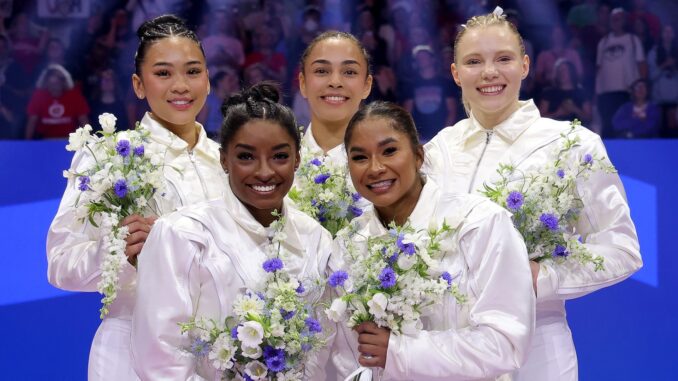
It wasn’t that long ago that the US women’s gymnastics team was a force to be reckoned with. Be it the Olympics or World Championships, Team USA would always emerge as the top two, with the likes of Simone Biles and co. leading the way. Take, for example, the Rio Olympics, the Paris Olympics, and the subsequent world championships. Sadly, those days of dominance are looking like a distant past at the moment. In the recently concluded world championships in Jakarta, Indonesia, Team USA women had just two medals to their name.
For Team USA, Leanne Wong had Olympic experience, though she’d only traveled to Tokyo and Paris as an alternate. And as expected, Wong looked well on course to clinch her all-around gold. However, what has now become a controversial decision from the judges saw Russia’s Angelina Melnikova take the gold in her return as a neutral athlete. Apart from Wong, Joscelyn Roberson claimed bronze on vault. But Wong and Roberson aside, the women’s team had little to celebrate.
The US women’s team returned with the lowest medal haul since 2001. This was also the first time since 1979 that the men’s gymnastics team earned more medals than the women. So what happened? For many years, the US women’s gymnastics team had a strong core with a legendary lineup. The likes of Suni Lee, Simone Biles, Aly Raisman, Nastya Liukin, and more were both dominant and consistent in their results, especially on the biggest stages.
But with the retirement of Biles, USA women don’t have that same level of firepower on their team. And with stars like Jade Carey and Lee taking a step back from elite gymnastics at the moment, the onus is now on the next crop of gymnastics hopefuls with no clear successors. Thus, a significant void has been formed. And as the women’s gymnasts are going through a transitional phase, it can be expected that there is still time left till LA28 for Team USA to get things on track. But even then, the uncertainties remain.
The Fall After the Flight
For years, the USA Gymnastics team has been the gold standard — literally. From Simone Biles’ gravity-defying performances to the consistent excellence of stars like Suni Lee and Jordan Chiles, the American women’s gymnastics team has dominated every major international competition.
But recently, something feels off. With Biles and several veterans stepping away, the once unstoppable force seems to have lost momentum. The absence of star power and leadership has left Team USA facing one of its most concerning performance dips in years.
So, what’s really happening behind the scenes? Let’s dive into the flips, falls, and factors shaping this uneasy chapter in USA Gymnastics history.
The Simone Biles Legacy: More Than Just Medals
Simone Biles isn’t just a gymnast — she’s a phenomenon. Her influence extends far beyond the sport. She brought charisma, technical brilliance, and emotional depth to gymnastics, redefining what excellence looks like.
Her signature moves — like the “Biles” on floor and vault — became so difficult that judges had to rewrite the scoring code. But perhaps her greatest contribution was her leadership and mental strength.
Without her on the mat, Team USA isn’t just missing points. They’re missing presence — that spark of inspiration that lifts the entire team’s confidence.
A Team Without Its Anchor
When Simone Biles decided to take a step back to focus on her mental health and well-being, it sent ripples through the gymnastics community. Many applauded her bravery, while others worried about Team USA’s performance stability.
And now, those concerns are becoming reality. The results speak for themselves — lower team scores, uncharacteristic mistakes, and a noticeable lack of cohesion.
Gymnastics, after all, is as mental as it is physical. Without the calm authority of Biles and her veteran teammates, younger gymnasts are being thrust into the spotlight faster than expected.
The Missing Energy: Why Leadership Matters in Gymnastics
A gymnastics team without its leaders can feel like a ship without a captain. Sure, everyone knows the routines, but who steadies the nerves when the pressure hits?
Simone Biles, alongside other experienced athletes, often played that emotional anchor role. She celebrated others’ successes, helped calm nerves before routines, and inspired belief even after falls.
Without her, that emotional glue is missing. It’s not just about athletic ability — it’s about mindset, motivation, and mentorship.
New Faces, High Expectations
Let’s not forget — Team USA still boasts tremendous talent. Young gymnasts like Skye Blakely, Joscelyn Roberson, and others are incredibly skilled. But raw skill doesn’t always translate into instant success on the global stage.
Competing internationally isn’t just about perfect execution; it’s about composure. And when you’re following in the shadow of a legend like Biles, the pressure can feel ten times heavier.
The Reality of Post-Biles Transition
Every dynasty in sports eventually faces a transition period. Michael Phelps retired, Usain Bolt stepped off the track, and now Simone Biles has taken a step back.
For Team USA Gymnastics, this is that moment. It’s not necessarily a downfall — it’s a recalibration. But the transition comes with growing pains: inconsistent performances, shaky landings, and a struggle to maintain dominance.
It’s a test of the system, not just the athletes.
Training Challenges and Team Chemistry
Reports suggest that the national training structure has been adapting since the changes post-Tokyo 2020. With newer coaching philosophies emphasizing athlete well-being over constant intensity, the shift — while positive — also requires adjustment time.
Chemistry is another key issue. The best teams train together long enough to predict each other’s rhythms. But with newer lineups and limited shared experience, synergy takes time to build.
Pressure Without the Spotlight
Ironically, without Biles, there’s less media pressure but more internal pressure. Every gymnast now feels the unspoken expectation to “fill Simone’s shoes.”
That’s a tall order — and perhaps an unfair one. These young athletes are carving their own paths, but comparisons are inevitable. Every wobble becomes magnified when you’re following the greatest of all time.
Fan Expectations vs. Athletic Reality
Fans have grown accustomed to seeing the USA dominate. Gold after gold became the norm. But that kind of dominance isn’t sustainable forever — especially in a sport where the margin for error is razor-thin.
The truth? Other countries have been stepping up their game. China, Brazil, and Great Britain are all producing world-class talent. The playing field is leveling, and Team USA must now fight harder than ever to stay on top.
Mental Health Revolution in Gymnastics
Let’s give credit where it’s due — Biles sparked an essential conversation about mental health in elite sports. Her decision to prioritize her well-being opened doors for younger athletes to speak up and seek help.
But balancing mental health awareness with performance expectations is a new frontier for USA Gymnastics. It’s a necessary evolution, but one that may come with temporary dips in dominance.
Can the Team Rebound Before Paris 2028?
The big question now is: can Team USA regain its footing before the next Olympic cycle?
Absolutely — but it will require patience and strategy. Consistent training, better team chemistry, and mentorship programs from veterans could help restore balance. If Biles or other stars return even part-time, that could reenergize the entire team.
Coaching Overhaul and Cultural Shifts
After years of controversy and reform, USA Gymnastics has been overhauling its culture. The focus has shifted from fear-based coaching to athlete empowerment.
This change, while healthy, also means reprogramming how young gymnasts approach competition. It’s no longer about perfection at all costs — it’s about sustainable excellence. That cultural evolution takes time but promises long-term success.

What Fans Can Do: Supporting Through the Slump
Instead of criticizing every missed routine, fans can play a part in the comeback. Support, patience, and understanding go a long way. These gymnasts are under immense pressure, representing a nation with sky-high expectations.
Let’s cheer them for their courage and resilience — not just their medals.
Simone’s Shadow or Simone’s Standard?
Ultimately, Biles’ absence is both a challenge and an opportunity. Her legacy sets a standard — one that inspires, not intimidates.
The question isn’t whether Team USA can be great again. It’s how they redefine greatness without her. Maybe it won’t look like the same old dominance — maybe it’ll look more balanced, more human, more real.
Conclusion: Falling Is Part of Flying
Every era in sports has its highs and lows. Team USA Gymnastics is simply in a rebuilding phase, learning to soar again without its brightest star. Simone Biles lit the path — now it’s up to the next generation to follow it, stumble, and rise stronger.
The beauty of gymnastics isn’t just in perfect routines; it’s in the resilience to keep getting back up after every fall.
